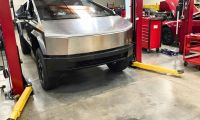According to Tesla, the Kato Road production team has managed to put out a total of 868,000 4680 cells over the past week. Something that, extrapolated, would basically mean covering a production of 1,000 cars over the last 7 days.
This is undoubtedly a very important step in order to reinforce Tesla's diversification plan, which has sought the best way so that the supply of batteries would not be an impediment to its growth; a plan that will actually accelerate in 2023 with the increase in their own capacity, which will allow them to enjoy greater autonomy and thus pave the sales expansion expected for 2023.
With this step they can also unlock some projects, such as accelerating the production of the Tesla Semi, as well as preparing the production lines that will shape the Cybertruck, the futuristic and somehow extravagant pick up truck that is scheduled to start production in the second half of 2023.

But the potential of these cells is indeed very high, especially when it comes to offering better production costs. The 4680 cells are of the cylindrical type and significantly larger than the 2170 being used so far in the Model 3 and Model Y. Betting on a larger format should allow Tesla to greatly reduce costs, since fewer casings are required, and by the way improving the use of of the available space inside the battery pack.
The capacity of these cells is a staggering 5 times higher than the previous generation, also offering 6 times more power, as per official Tesla sources. At the time of their presentation, the company stated that the use of 4680 battery cells would increase the range of its electric vehicles by approximately 16%; again, a very significant figure.
The 4680 cells have a simpler manufacturing process and fewer components, making production more efficient and cost effective. Without a doubt, these batteries are the key to Tesla's long term growth, which continues to be successful despite the economic crisis currently hitting the markets.
Tesla's new 4680 cell production record is enough for roughly 1 out of every 3 cars produced at Giga Texas. Not bad. https://t.co/QNggldREUD pic.twitter.com/c6cN5chSo3
Advertising — Torque News (@torquenewsauto) December 26, 2022
The commitment to the 4680 format will be accompanied by a new, faster and more efficient manufacturing method that should make it possible to reduce investments per GWh by 75%. The production lines, of up to 20 GWh per year each, are described by Tesla itself as "a highway instead of an urban road with traffic lights and intersections". The secret of this new process? Basically, the Maxwell Technologies electrode dry coating technology, which allows for easier fabrication and lower energy expenditure.
But this is a new process that nonetheless has been plagued with problems to be effectively implemented; experts in turn say that once Tesla achieves full-scale production of these cells, it will be able to cut the cost of Model Y batteries in half, which would translate into savings of $5,500 per unit (of which 2,000-3,000 have already been achieved thanks to the very design of the cells).
Congrats to the 4680 cell team on achieving 868k cells built in the last 7 days—equal to 1k+ cars! pic.twitter.com/CaC7Js9aEL
— Tesla (@Tesla) December 25, 2022
A step forward in production capacity, by all means, and also a step forward in cost reduction. Two pillars that can allow the brand to continue its unstoppable growth in 2023. We can surely say that this technological leap taken by Tesla is closely watched by other manufacturers, proving once again to be a benchmark for the industry as a whole, a trend that seems far from changing.
Source: teslarati
All images courtesy of Tesla Inc.
Nico Caballero is the VP of Finance of Cogency Power, specializing in solar energy. He also holds a Diploma in Electric Cars from Delft University of Technology in the Netherlands, and enjoys doing research about Tesla and EV batteries. He can be reached at @NicoTorqueNews on Twitter. Nico covers Tesla and electric vehicle latest happenings at Torque News.













Comments
The capacity must be 5 times
Permalink
The capacity must be 5 times higher because the cell is more than 5 times bigger than the 2170 cell... So this is not an improvement if you are looking for more energydensity.
Will it be possible/practical
Permalink
Will it be possible/practical to replace the battery in my brand new Model 3 with a 4680 battery when they become available?